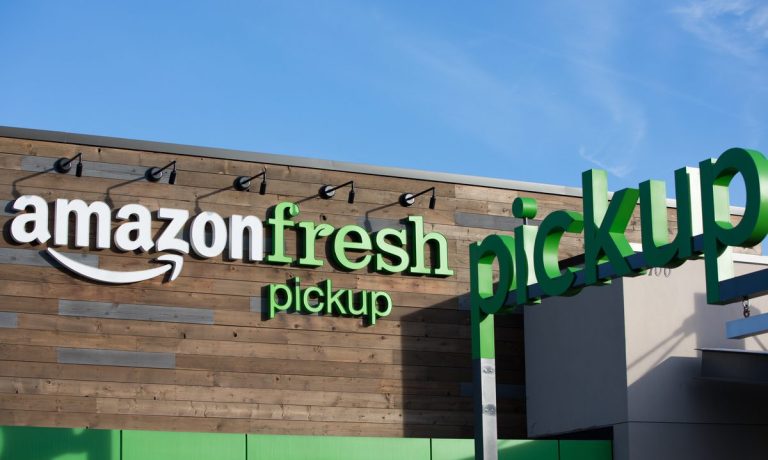After losing to Instacart at the aggregator game, Amazon has pivoted to first-party grocery sales with the rapid expansion of its Fresh brand. On Thursday (Dec. 16), the retail giant opened its tenth Amazon Fresh store in California, the Orange County Register reported. The locations is the second large-format store in the state utilizing the retailer’s “Just Walk Out” technology whereby consumers can check in at the entrance, pick the products they want, and exit the store without stopping at a checkout kiosk or counter.
The brand now operates 23 physical stores in addition to its nationwide eGrocery business. Additional locations are rumored to be coming to Connecticut, Illinois and Virginia, among other areas. According to PYMNTS data from earlier this year, Amazon holds a roughly 2% share of the U.S. grocery market, bringing in $24.3 billion from its grocery channels. However, much of this haul comes from Whole Foods Market, rather than the company’s more tech-forward Fresh brand. Meanwhile, Instacart brought in $1.5 billion in revenue in 2020.
Related: Is Amazon About To Start A Food Fight With Walmart Over Physical Stores?
In fact, while Amazon may not have been able to hack it in Instacart’s space, Instacart has begun to make moves that suggest it could foray into Amazon’s, eyeing first-party online grocery fulfillment. As far back as February, the Financial Times reported that Instacart was looking into dark stores. The first of these dark stores has remained in line with Instacart’s third-party fulfillment model, a virtual convenience store in partnership with Kroger. Still, it is not a great stretch to imagine that, much as DoorDash has entered the virtual kitchen space, Instacart could leverage its dark store capabilities to compete with the grocers on its platform.
Read more: DoorDash Opens Second Virtual Kitchen
When it comes to grocery, consumers prefer buying direct to buying from third-party marketplaces, according to data from PYMNTS’ study, What Consumers Expect From Their Grocery Shopping Experiences, created in collaboration with ACI Worldwide, which featured a census-balanced survey of more than 2,300 U.S. adults.
Advertisement: Scroll to Continue
You may also like: Digital Features Can Help Grocers Win Over 43 Percent Of Shoppers
The study found that 23% of grocery shoppers buy online from grocers’ direct channels and have the products delivered to their houses, with 8% of those surveyed marking the channel as their most preferred one. Meanwhile, only 11% reported that they buy online using an aggregator that delivers the products the same day, and just 2% rated this purchasing method as their most preferred. Overall, only 18% of grocery shoppers prefer buying online to buying in stores, suggesting that Amazon’s move to open more consumer-facing stores is a savvy one.
“You look at a grocery store and just stand in an aisle and watch people shop — the human behavior you see in the store doesn’t look a lot different than it did 10 years ago, or 20 or 50 years ago,” John Ross, president and CEO of the Independent Grocers Alliance (IGA), told PYMNTS in a recent interview. “That doesn’t mean the shopper is the same, and those shoppers have a digital relationship with most of the brands and services in their lives, and so their expectation of our industry to be able to have a digital connection with them is growing and growing and growing.”
See also: Supermarkets Rethink Physical and Digital Aisles for Grocery’s Connected Future




